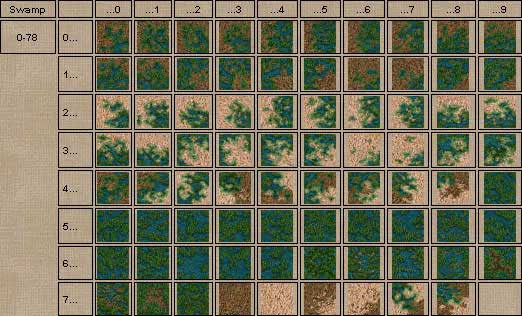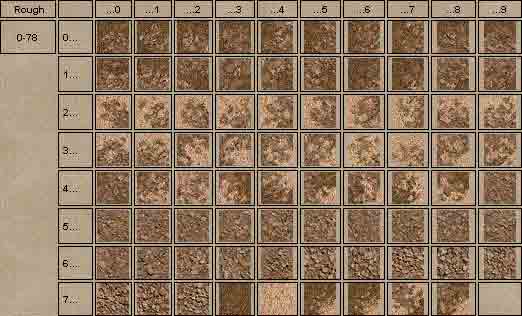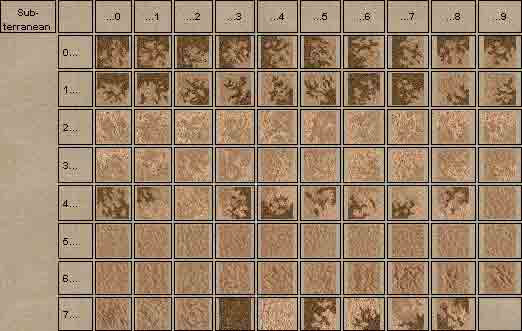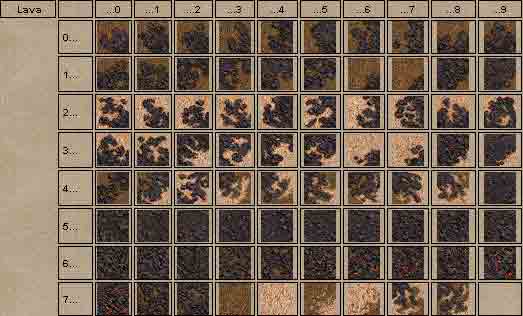TERRAIN (TR)
RECEIVER
Used to set terrain types or change
passability of a square.
| !!TRx/y/l:XXXX; |
Set a Terrain type or change passability
of a square at the specified x,y,l location. |
| !!TR#:XXXX; |
Alternative method to above. Uses indirect reference:
x=v[#], y=v[#+1], l=v[#+2]
|
OPTIONS
| E$; |
Mark the square as an
object entrance (yellow trigger square)
$ = 0 means yellow trigger.
$ =1 means no yellow trigger (1). |
| E?$1/?$2/?$3; |
Get/check object entrance position
This command lets you get position of entrance of an object (x/y/level)
If there is no object at the position, the coordinates passed to TR reciever are returned. If you pass coordinates of a red square of an object to it, it would return croordinates of its entrance.
|
G?$; |
Return the topmost terrain overlay.
You may only use GET or CHECK
syntax.
(See Format TO) |
| G$1/$2; |
Get type & subtype of topmost terrain overlay
$1 - type
$2 - subtype
Type 40 subtypes starting with 10000 are recognized as new WoG terrain overlays. You can give them any effect with a script.
|
| P$; |
Set/check/get a
passability of the square (red square)
$ = 1 means passable.
$ = 0 means not passable. |
| T$1/$2/$3/$4/$5/$6/$7/$8; |
Set/check/get a
terrain type
$1 -
type of land
$2 -
subtype of land
$3 - type
of river
$4
- subtype of river
$5 - type of
road
$6
- subtype of road
$7 - type
of mirror
$8 - Bit mask of accessability
Comments: above. |
| V$; |
Set/check/get a
visibility of a square (one bit - one color)
Comments:
This is similar to the UN:S and UN:H but for individual squares and you
can check or get the value. Also, monsters have sight (1 hex)and this
can be enabled or disabled -- they have a bit value number of 256. |
Explanation of T
1. Terrain
type:
| 00 |
 |
Dirt |
| 01 |
 |
Sand |
| 02 |
 |
Grass |
| 03 |
 |
Snow |
| 04 |
 |
Swamp |
| 05 |
 |
Rough |
| 06 |
 |
Underground |
| 07 |
 |
Lava |
| 08 |
 |
Water |
| 09 |
 |
Rock |
2. Terrain Subtype:
Dirt

Sand

Grass

Snow

Swamp

Rough

Underground

Lava

Water

Rock

3. River Type:
| 01 |
Clear |
| 02 |
Icy |
| 03 |
Muddy |
| 04 |
Lava |
4.
River Configuration:
| 00, 01, 02, 03 - 4 styles of
segment |
+---+
¦ +-¦
+---+ |
| 04 - segment: |
+---+
¦-+-¦
+---+ |
| 05, 06 - 2 styles of segment: |
+---+
¦---¦
+---+ |
| 07, 08 - 2 styles of segment: |
+---+
¦ ¦-¦
+---+ |
| 09, 0A - 2 styles of segment: |
+---+
¦ ¦ ¦
+---+ |
| 0B, 0C - 2 styles of segment: |
+---+
¦---¦
+---+ |
5. Road Type
| 01 |
Dirt |
| 02 |
Gravel |
| 03 |
Cobblestone |
6.
Road Configuration:
| 00,01,02,03,04,05 - 6 styles
of segment: |
+---+
¦ +-¦
+---+ |
| 06, 07 - 2 styles of segment: |
+---+
¦ ¦-¦
+---+ |
| 08, 09 - 2 styles of segment: |
+---+
¦---¦
+---+ |
| 0A, 0B - 2 styles of segment: |
+---+
¦ ¦ ¦
+---+ |
| 0C, 0D - 2 styles of segment: |
+---+
¦---¦
+---+ |
| 0E - segment |
+---+
¦ ¦ ¦
+---+ |
| 0F - segment |
+---+
¦ --¦
+---+ |
| 10 - segment |
+---+
¦-+-¦
+---+ |
7. Mirror
Type:
Bits: 76543210
--CcBbAa ('-' means no matter)
a - vertical mirror for land type (not for all land
types)
A - horizontal mirror for land type (not for all
land types)
b - vertical mirror for river type
B - horizontal mirror for river type
c - vertical mirror for road type
C - horizontal mirror for road type
More Explanations about mirror type
Say, this is:

This will be shown if you use mirror=0
Then set first bit (mirror=1). This will mirror the square vertical to:

Or set second bit (mirror=2). This
will mirror the square horizontal to:

Or set both bit (mirror=3[2+1]).
This will mirror the square h and v to:

The same about mirroring the river
and road.
River h mirror=4
River v mirror=8
River both mirror=12[8+4]
Road h mirror=16
Road v mirror=32
Road both mirror=48[32+16]
You can combine all mirroring.
Say square mirror h, river mirror v and road mirror h and v mirror=
57[1+8+16+32]
8. bit mask of accessability
mt: bit mask of accessability
Bits: 76543210
???E???P ('?' means no info)
P - passability
E - enrtance
These bits may be set individually by TR:P and TR:E commands.









